Photographer takes award with image of a solar eclipse, Yang Feiyue reports.
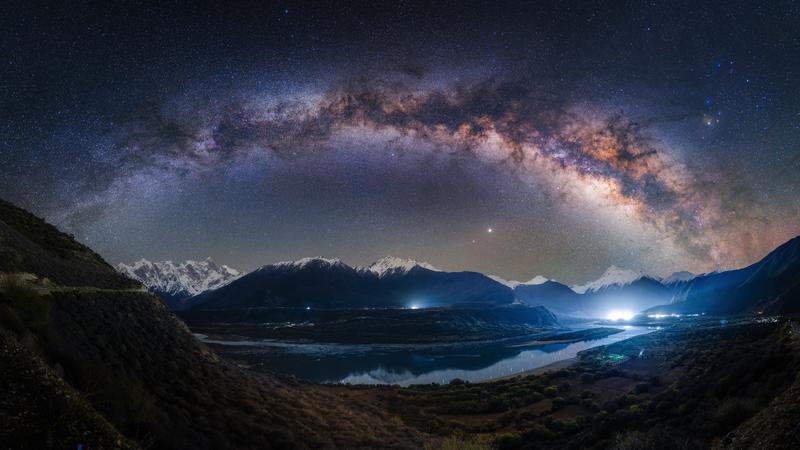 The Milky Way arches across the night sky above the Yarlung Zangbo Grand Canyon in the Tibet autonomous region. (PHOTO PROVIDED TO CHINA DAILY)
The Milky Way arches across the night sky above the Yarlung Zangbo Grand Canyon in the Tibet autonomous region. (PHOTO PROVIDED TO CHINA DAILY)
Dong Shuchang from Northwest China's Ningxia Hui autonomous region captured the solar eclipse on June 21, 2020, in his photography work The Golden Ring, becoming the winner of the 2021 Astronomy Photographer of the Year competition in mid-September.
Hosted by the Royal Observatory Greenwich, the competition received 4,500 entries from 75 countries and regions.
Dong's image also won in the competition's "our sun" category.
The Golden Ring shows the moon blocking out most of the solar disc and leaving only a thin ring of sunlight shining through.
Dong started to prepare for the trip to take the shots toward the end of 2019.
He got the necessary gear in place, planned the location for the photographs, route and transportation, and thought ahead of how he'd like to present the theme, composition, expression and colors in the photos.
"In fact, I had everything covered in my head," says the 23-year-old, adding that he figured all he had to do was open the camera and press the shutter.
However, that didn't go as he expected. The COVID-19 pandemic put a brake on his plans in early 2020. "All of a sudden, everything became uncertain."
Thanks to the effective pandemic control in China, Dong moved with his plan in the middle of last year. As he finally hit the road, it was still a rough ride. He and his friends encountered some problems on their way to Ngari prefecture in the Tibet autonomous region to take photos of the solar eclipse.
"We were inches away from driving into a lake, and met a wild animal," he recalls.
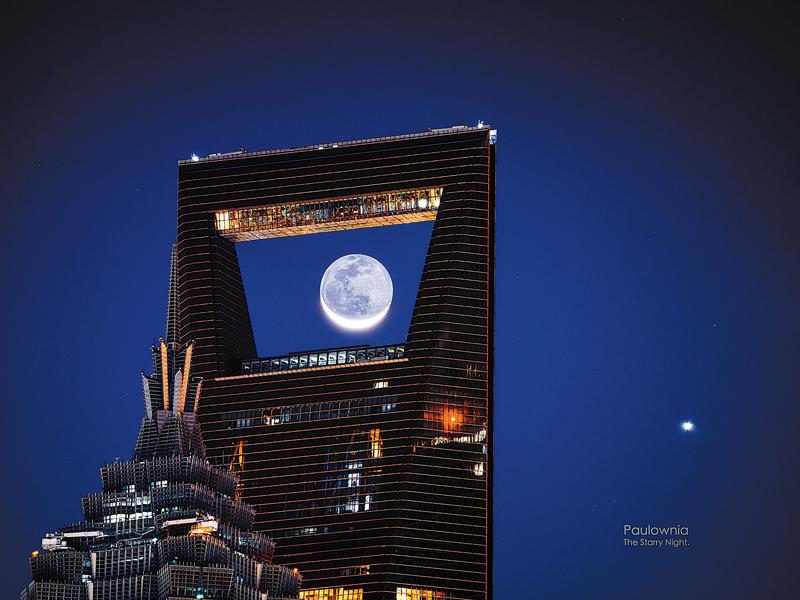 A crescent moon framed by the Shanghai World Financial Center. (PHOTO PROVIDED TO CHINA DAILY)
A crescent moon framed by the Shanghai World Financial Center. (PHOTO PROVIDED TO CHINA DAILY)
He had to juggle between finishing education assignments online-as a fourth-year student majoring in logistics management at Tianhua College of Shanghai Normal University-and getting ready for the shoot. When Dong and his friends finally reached their destination, the sky was blocked by thick clouds.
"You had to be there to feel the frustration of about 100 photographers who were ready and waiting for the solar eclipse," he says.
But magic seemed to happen. The clouds moved away and the sun came out. Dong clicked.
"I try to keep it simple-a clean picture with a highlighted subject," Dong says.
Through two different exposures, Dong superimposed two eclipse photos. "It made the image simple yet dynamic."
He also controlled light and shade so that the image retained the mountains on the moon's surface blocking the sun's light. The idea was to show the relationship among the sun, the Earth and the moon, he explains.
Emily Drabek-Maunder, who is an astronomer at the Royal Observatory Greenwich, says: "Solar eclipses have been capturing the interest of humans for thousands of years across the world. This image demonstrates both the beauty and simplicity of an eclipse, but also the science behind this astronomical event.
"Our sun can still be seen as a ring circling the moon as it passes in front of the sun, and mountains on the lunar surface can be seen hiding some of this light on the lower right-hand portion of the image. This is a stunning achievement."
Another judge of the photography contest, Steve Marsh, says Dong's work is a perfect capture of the natural phenomenon through a perceptual, calm and professional approach. The image gave Marsh the impression that "you could reach into the sky and place this onto your finger".
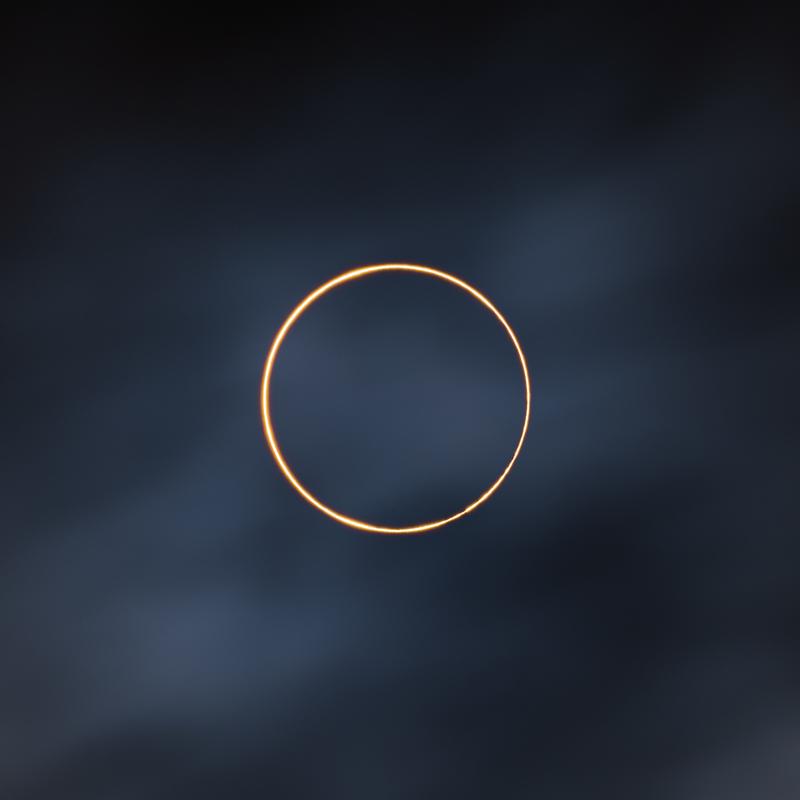 The Golden Ring, Dong Shuchang's award-winning image at the 2021 Astronomy Photographer of the Year competition. (PHOTO PROVIDED TO CHINA DAILY)
The Golden Ring, Dong Shuchang's award-winning image at the 2021 Astronomy Photographer of the Year competition. (PHOTO PROVIDED TO CHINA DAILY)
Early interest
Dong was drawn to the mystery of the universe in childhood. He was amazed by the asteroid images in British physicist Stephen Hawking's book, A Brief History of Time, that his father bought for him.
Later, the family bought him a toy telescope that enabled him to see the moon up closer.
He went on to explore astronomical documentaries and films. During the winter vacation in his first college year in Shanghai in 2018, Dong's mother gave him the book, Xingkong Sheying Biji (Star Photography Notes) written by award-winning photographer Wu Zhong, which encouraged him further to pursue his passion.
"Astronomy photography enables me to record details that are usually missed by the naked eye," Dong says.
He adds that when he uses telephoto lens to take photos, he can see, for example, the details of the Milky Way, as well as its red, green and blue colors that "can be brought into sharp relief through photography".
Such photography prompted Dong to acquire knowledge of the field.
"I got to know how temperature and air composition can result in different star colors, such as blue and yellow that are shown in the images," he says.
"It is also thrilling when you can see something (in photos) in the great distance like the Andromeda Galaxy."
Dong met with Wu and sought his advice to hone his skills. Dong learned how to take control of elements and color in an image.
"You need to know what you want to express and how to find your own angle," he adds.
For the purpose, a high-sensitivity camera that brings down noises is required, and photos of different exposure time are needed for overlay later, he says.
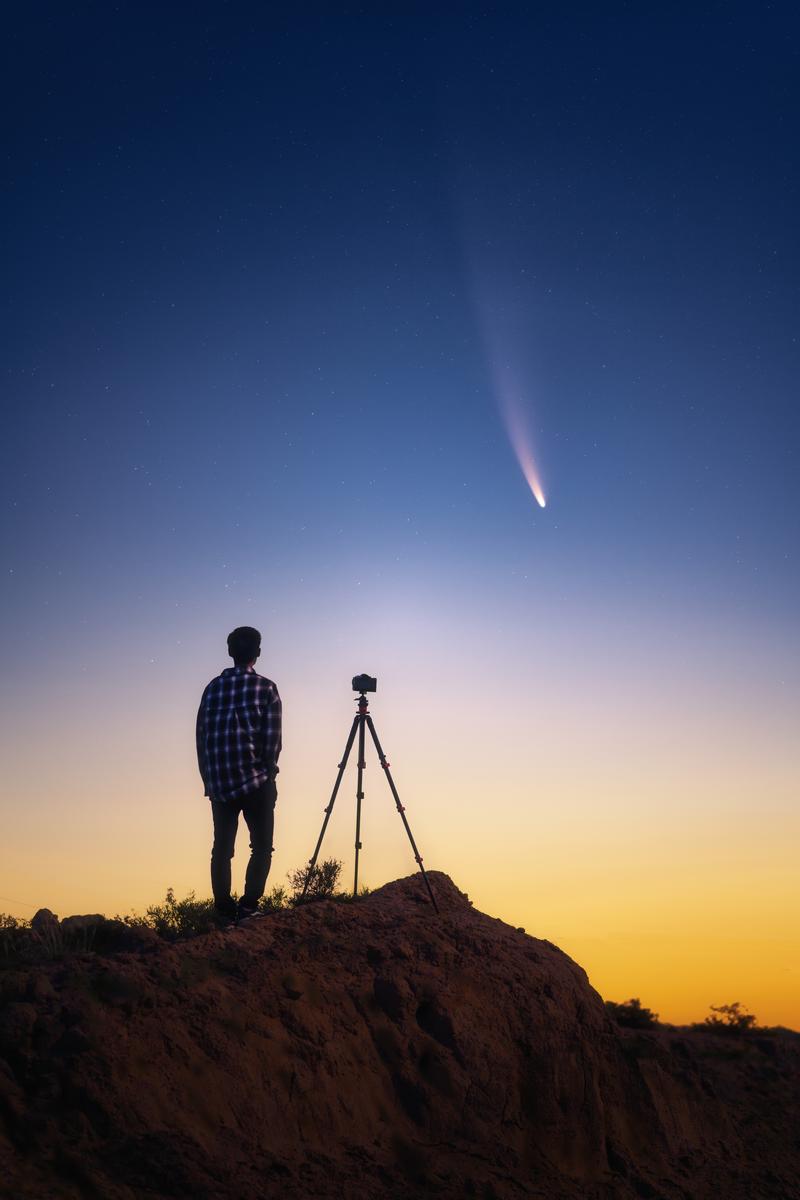 Dong travels off the beaten trail to chase stars and take photos. Memorable moments include observing a comet in Yinchuan, Ningxia Hui autonomous region. (PHOTO PROVIDED TO CHINA DAILY)
Dong travels off the beaten trail to chase stars and take photos. Memorable moments include observing a comet in Yinchuan, Ningxia Hui autonomous region. (PHOTO PROVIDED TO CHINA DAILY)
Beaten trail
He threw his hat in the ring of the 2019 Astronomy Photographer of the Year competition. "It was well-known to people in the circle, so I wanted to put my skills to test through it."
Dong's self-confidence got a shot in the arm after winning the best newcomer award with his work, Sky and Ground, Stars and Sand.
"It was unexpected and a big encouragement," he says.
Dong went on to win the championships at several major photography competitions, including the 2021 photography contest by the Beijing Planetarium and the Chinese undergraduate astronomical photography contest this year held by the Fudan Astronomy Society.
He has also worked for professional photography organizations, including 8KRAW and CSVA.
Dong says more than three years of chasing the stars has brought excitement and accomplishment in his life, although the process was often mixed with sweat and tears.
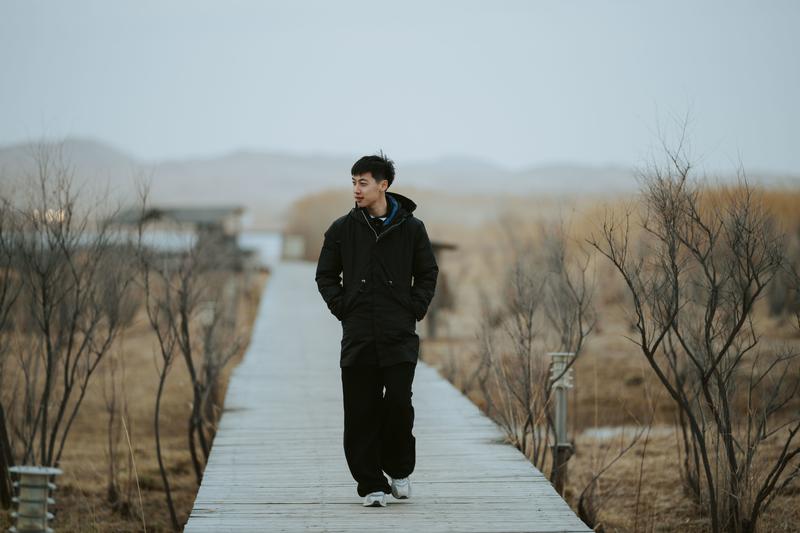 Dong travels off the beaten trail to chase stars and take photos. Memorable moments include observing a comet in Yinchuan, Ningxia Hui autonomous region. (PHOTO PROVIDED TO CHINA DAILY)
Dong travels off the beaten trail to chase stars and take photos. Memorable moments include observing a comet in Yinchuan, Ningxia Hui autonomous region. (PHOTO PROVIDED TO CHINA DAILY)
Sichuan province, and Tibet, Ningxia Hui and Xinjiang Uygur autonomous regions are ideal for star observation.
"They have less pollution and moisture, and more clear skies, which don't interfere with the clarity of the atmosphere," Dong says.
He also prefers taking pictures in deserts, where the wind is usually slow and sand dunes are easier to climb for better sky views.
Dong graduated from college in July and got a job dealing with promoting cameras in Shanghai. The job allows him to keep abreast of advanced camera techniques and get in touch with photography experts.
In late September, Dong went on a photography trip, sponsored by the Chinese National Geography magazine, to Qomolangma, also known in the West as Mount Everest.
"The idea was to record grand nature, especially in places off the beaten tracks, and find differences in the region over the past 100 years," Dong says.
The adventure led him to learn to hike in the wilderness and study formations of glacier and climate in mountainous areas.
His breath was taken away by the biodiversity, including forest trees, tropical and meadow plants, snowy peaks, glaciers and moraine lakes in a valley 4,000 meters above sea level.
The stunning views of the giant mountain peaks turned pink by the sunrise made Dong forget his altitude sickness. "I will surely go back again."
Speaking about his future plan, Dong says he will explore new photography fields and better ways to integrate science and art.
Contact the writer at yangfeiyue@chinadaily.com.cn


